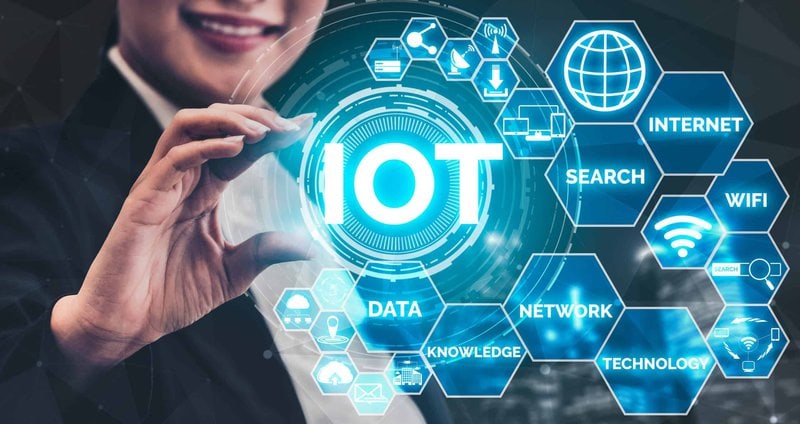Why Interconnectivity Is Crucial for Iot Ecosystems

Are you curious about why interconnectivity is so important for IoT ecosystems? Well, you’re in the right place!
In this article, we’ll explore the significance of interconnectivity in IoT and how it enhances efficiency.
You’ll also discover the various benefits of interconnectivity and the challenges it presents, along with the solutions to overcome them.
So, if you’re ready to delve into the role interconnectivity plays in the growth of IoT ecosystems, keep reading!
Key Takeaways
- Enables seamless communication and data sharing between devices
- Overcomes interoperability challenges caused by different communication protocols
- Addresses security concerns related to unauthorized access and data breaches
- Enhances efficiency and growth of IoT ecosystems
The Importance of Interconnectivity in IoT Ecosystems
Interconnectivity is essential for IoT ecosystems because it allows devices to communicate and share data seamlessly. In today’s world, where technology is becoming increasingly interconnected, it is crucial for IoT devices to be able to communicate with each other effectively.
However, there are interoperability challenges that need to be overcome. Different devices from different manufacturers often use different communication protocols, making it difficult for them to communicate and work together seamlessly. This interoperability challenge can hinder the growth and efficiency of IoT ecosystems.
Additionally, security concerns also arise due to the interconnectivity of devices. With data being transmitted between devices, there is a risk of unauthorized access and data breaches. Therefore, ensuring robust security measures is vital to protect sensitive information and maintain the trust of users in IoT ecosystems.
Enhancing Efficiency Through Interconnectivity in Iot
In this discussion, we will explore how interconnectivity in IoT can enhance efficiency by streamlining data exchange and maximizing resource utilization.
By seamlessly connecting devices and systems, you can ensure a smooth flow of data and information, eliminating bottlenecks and delays. This streamlined data exchange allows for real-time decision-making and improved operational efficiency.
Additionally, interconnectivity enables the efficient use of resources by optimizing their allocation and utilization, leading to cost savings and improved productivity.
Streamlining Data Exchange
To streamline data exchange in your IoT ecosystem, you’ll need to ensure seamless communication between devices and platforms. This involves integrating data from various sources and enabling devices to transmit information smoothly.
Data integration is crucial because it allows you to gather and analyze data from multiple devices, providing a holistic view of your IoT system. By seamlessly communicating with each other, devices can share relevant data in real-time, enabling quick decision-making and efficient operations.
This seamless communication also ensures that data is transmitted securely and accurately, reducing the risk of errors or delays. With seamless communication and data integration, your IoT ecosystem becomes a well-connected network, enabling you to harness the full potential of your devices and platforms.
Maximizing Resource Utilization
By maximizing resource utilization, you can optimize the efficiency and effectiveness of your IoT devices and platforms. This not only helps you save costs but also ensures that your devices and networks perform at their best.
Here are three key ways to achieve this:
- Efficient Energy Management: By implementing energy-saving techniques such as sleep modes, power profiling, and intelligent scheduling, you can maximize energy efficiency and extend the battery life of your IoT devices.
- Network Optimization: Utilize advanced algorithms and protocols to optimize network connectivity, reduce latency, and enhance data transmission speed. This ensures smooth and seamless communication between devices and platforms.
- Resource Allocation: Allocate resources intelligently by prioritizing critical tasks and dynamically adjusting resource allocations based on real-time demands. This helps prevent bottlenecks and ensures optimal utilization of resources.
Exploring the Benefits of Interconnectivity in IoT
In this discussion, we will delve into the benefits of interconnectivity in IoT, focusing on two key points: improved data sharing and enhanced system efficiency.
When devices are interconnected, data can be seamlessly shared between them, allowing for more accurate and comprehensive insights.
Additionally, this interconnectivity leads to an enhanced system efficiency, as devices can communicate and collaborate in real-time, optimizing processes and reducing downtime.
Improved Data Sharing
You can enhance data sharing within IoT ecosystems by implementing improved interconnectivity. This is crucial for ensuring the smooth flow of information and maximizing the benefits of IoT technology.
With enhanced interconnectivity, you can achieve the following:
- Improved data security: By establishing strong connections between devices and networks, you can strengthen the security measures in place. This ensures that sensitive data is protected from unauthorized access and potential breaches.
- Real-time analytics: With better interconnectivity, data can be transmitted and analyzed in real-time. This allows for quick decision-making and the ability to respond promptly to changing circumstances. Real-time analytics also enable businesses to gain valuable insights and identify patterns or trends that may otherwise go unnoticed.
- Efficient collaboration: Improved interconnectivity promotes seamless communication and collaboration between different devices and systems. This allows for efficient sharing of data, enabling teams to work together more effectively and make informed decisions based on accurate and up-to-date information.
Enhanced System Efficiency
To maximize system efficiency, focus on optimizing device connectivity and streamlining data transmission.
Improving communication and optimizing connectivity are key factors in enhancing system efficiency within IoT ecosystems. By ensuring seamless connectivity between devices, you can facilitate real-time data sharing and faster decision-making processes.
Streamlining data transmission, on the other hand, allows for faster and more accurate data analysis, which can lead to improved system performance. By implementing efficient communication protocols and utilizing reliable connectivity options, you can minimize data latency and ensure a smooth flow of information within your IoT network.
This not only improves the overall efficiency of the system but also enhances user experience and enables the successful deployment of IoT solutions in various industries.
Challenges and Solutions for Interconnectivity in IoT
One major challenge for interconnectivity in IoT ecosystems is the compatibility of different devices and protocols. Ensuring that devices from different manufacturers can communicate seamlessly is crucial for the success of IoT projects. Here are some challenges and solutions to achieve interoperability standards:
- Device heterogeneity: With various devices using different protocols, it can be difficult to establish a unified communication framework. One solution is to adopt open standards like MQTT or CoAP that allow devices to interact regardless of their protocols.
- Security concerns: The diverse range of devices in IoT ecosystems poses security risks. Implementing robust security measures, such as end-to-end encryption and authentication protocols, can address these challenges.
- Legacy systems integration: Many existing systems may not be compatible with IoT devices. Using gateway devices or middleware solutions can bridge the gap between legacy systems and IoT devices.
The Role of Interconnectivity in the Growth of IoT Ecosystems
With seamless connectivity between devices, the growth of IoT is fueled by the role of interconnectivity in enabling efficient communication and data exchange. Interconnectivity plays a crucial role in the scalability of IoT ecosystems.
As the number of connected devices continues to increase, the ability for these devices to seamlessly communicate and exchange data becomes essential for the smooth functioning of the entire ecosystem. The scalability of IoT depends on the interconnectivity between devices, allowing for the expansion and integration of new devices and technologies.
Additionally, interconnectivity plays a vital role in ensuring the security of IoT ecosystems. By establishing secure connections between devices, data can be protected from unauthorized access and potential cyber threats.
Interconnectivity, therefore, serves as the backbone of the IoT ecosystem, enabling its growth, scalability, and security.
Future Trends and Innovations in Interconnectivity for IoT
Now, let’s look ahead and explore the future challenges and emerging technologies in interconnectivity for IoT.
As technology continues to evolve, the interconnectivity of IoT ecosystems will face new obstacles and exciting possibilities. Here are three trends to keep an eye on:
- 5G Networks: The arrival of 5G will revolutionize IoT connectivity, offering faster speeds, lower latency, and increased capacity. This will enable real-time data transmission and support a massive number of connected devices.
- Edge Computing: With the exponential growth of IoT devices, processing data in the cloud may become impractical. Edge computing brings the processing power closer to the devices, reducing latency and improving efficiency.
- Blockchain Technology: As IoT devices become more interconnected, ensuring security and trust becomes paramount. Blockchain technology offers a decentralized and tamper-proof solution, enhancing data integrity and privacy.
These emerging technologies will shape the future of interconnectivity, bringing both challenges and opportunities for IoT ecosystems.
Frequently Asked Questions
What Is the Definition of Interconnectivity in the Context of Iot Ecosystems?
Interconnectivity in the context of IoT ecosystems means the ability of devices to connect and communicate with each other. It is important because it allows for seamless data sharing and enables the benefits of IoT technology.
How Does Interconnectivity Impact the Overall Efficiency of Iot Ecosystems?
Interconnectivity plays a crucial role in optimizing IoT device performance. It impacts the overall efficiency of IoT ecosystems by facilitating seamless communication between devices, enhancing data sharing, and enabling real-time analysis for better decision-making.
Can You Provide Examples of Real-World Applications Where Interconnectivity Has Improved the Functionality of Iot Devices?
Interconnectivity has improved the functionality of IoT devices in real-world applications. For example, smart home systems can connect devices like thermostats, lights, and security cameras, allowing users to control them remotely for convenience and enhanced security.
What Are Some Common Challenges Faced When Implementing Interconnectivity in Iot Ecosystems, and How Can They Be Overcome?
Challenges faced when implementing interconnectivity in IoT ecosystems include compatibility issues and security concerns. Solutions involve using standardized protocols, implementing strong encryption measures, and regularly updating software to address vulnerabilities.
What Are Some Emerging Trends and Innovations in Interconnectivity That Are Expected to Shape the Future of Iot Ecosystems?
Emerging trends and innovations in interconnectivity, like edge computing and 5G technology, will shape the future of IoT ecosystems. These advancements will enable faster and more secure data transfer, enhancing the efficiency and functionality of connected devices.






